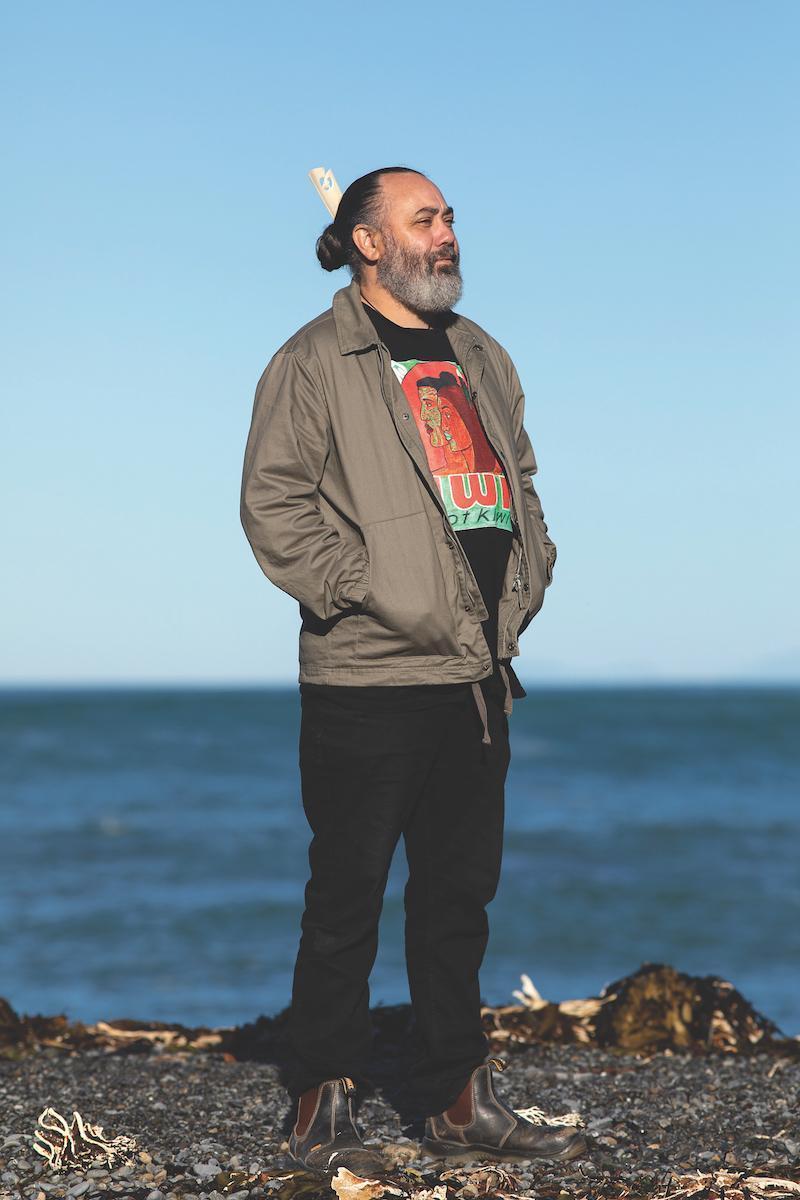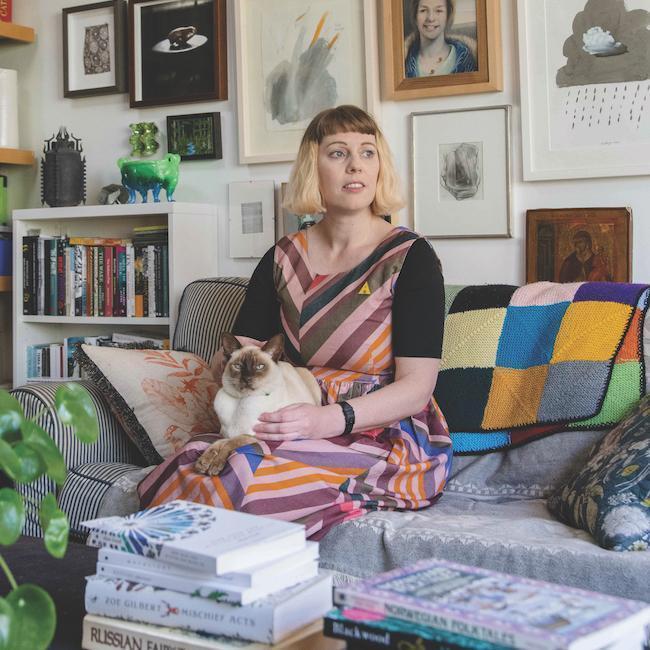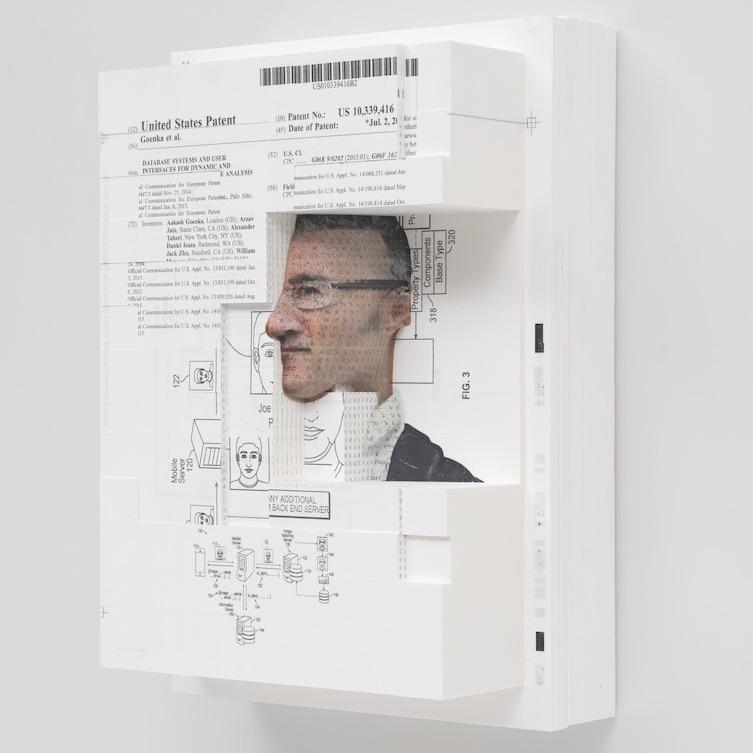Something Bigger
The meaning of Ngataiharuru Taepa’s work is hard to translate in certain terms; they speak from within Māori knowledge systems to tell stories greater than the cosmos itself.
Words: Kirsten Garner Lyttle
Photography: Russell Kleyn
I had a Zoom conversation with Ngataiharuru Taepa (Te Arawa, Te Āti Awa) on a Sunday morning. A digital and virtual face-to-face first meeting across the ditch. We discussed whānau (family), whakapapa (genealogy), coronavirus and lockdowns, Masters of contemporary Māori art such as Sandy Adsett and Robert (Bob) Jahnke, some of the (arguably academic) distinctions between customary and contemporary Māori art, artistic collaboration, the dawn, the marae (the court- yard or the open area in front of the wharenui, or meeting house), lollies, materiality, active and passive spaces, trauma, academia, his recent exhibitions, and kōwhaiwhai (Māori abstract, yet still referential paintings, found within wharenui or meeting houses, with customary patterns that represent the natural world and relationships in the environment), among other things. Taepa was generous with his time and his abundant positivity. An intentional positivity and intellectual playfulness – deeply embedded in mātauranga Māori (Māori knowledge) and kaupapa Māori (Māori framework and principals). A positivity that can be experienced within his artwork and one that responds to a time of pandemic, anxiety, renewal, and a return to some kind of normality. In other words, the now.
As with all mātauranga Māori (Māori knowl- edge), the starting place is the whakapapa (the genealogy). The map of the relationships between all beings and all things. More than simply a family tree, whakapapa is a line of descent from ancestors (and deities) down to the present day, linking all people and things back to the origins of creation. From a Māori perspective, it is this unbroken line that gives mana (authority, spiritual power) and value. For Taepa, whakapapa is a key aspect of his practice. Artmaking seems less a conscious choice, and more a reflection of the creative environment he grew up in; one that he considers a way of living and being.
Taepa is a third-generation artist. On his maternal side, his grandmother Mavis Newland is a well-respected painter, while his paternal grandfather’s brother was a carver from Ohinemutu. His father, Wi Te Tau Pirika Taepa (Te Arawa, Ngati Whakaue, Te Āti Awa) is a renowned Māori artist who has recently been named an officer of the New Zealand Order of Merit for services to Māori art, particularly ceramics. Ngatai’s brother is Kereama Taepa, a multidisciplinary artist who combines Māori customary art with digital technologies. While Ngatai’s partner is artist Saffronn Te Ratana (Ngāi Tūhoe), who also comes from a family of artists. The couple has worked collaboratively with their friend Hemi Macgregor on their installation Ka Kata Te Po, 2013 in response to the unlawful and violent Urewera police raids of 2007 on the people of Tūhoe (including Te Ratana’s relatives).
Using the visual language of kōwhaiwhai, Taepa’s work draws upon cosmological and genealogical narratives to respond to contemporary issues facing Māori people. As Taepa explains, “You know another word for kōwhaiwhai is tuhituhi, which is the word we now use for writing. Kōwhiawhai was the writing of our ancestors. That’s the way they decided to describe what they saw in the world through the written language of tuhituhi or kōwhaiwhai. I’m quite conscious that this art form pre-dates, in our culture, the written word and part of my Master’s was the impact of the written word on our visual culture and on kōwhaiwhai.”
During our conversation, Taepa’s Zoom virtual background displayed what appeared to be a detail of He ata ki runga, he ata ki raro, 2020. This three-panelled kōwhaiwhai piece was commissioned for Toi Tū Toi Ora: Contemporary Māori Art: 2020 – 2021, the largest exhibition of contemporary Māori art shown at Auckland Art Gallery. Or, is this virtual background Ata hāpara, (The dawn), shown in his 2020 exhibition Kia Āio Te Whenua at Page Galleries, Wellington? (Taepa also had a solo show at Page Galleries, which has represented Taepa for more than 20 years, in May 2022). These recent works are inspired by karakia (prayers, chants, and incantations). Karakia, as Taepa refers to it, can be different to prayer – rather than words of worship, karakia can be describing a sequence that happens in our environment. It can be an acknowledgement of things around us. It can be the sequence seen in the beginning of a calm day. The soft pastel tones of pink, yellow and blue seen in these works appear comfort- ing to my eyes; reminding me of ice cream or baby clothes, or perhaps the dawn referred to in the title.
Taepa’s recent works continue his commitment to being a student of kōwhaiwhai, and part of its intention is to bring a sense of stability of wellbeing. The patterned shapes of kōwhaiwhai are culturally and tribally loaded; referring to koru (fern frond), pītau (young shoot of a fern), kape (Crescent moon or eyebrows), kowhai ngutu kaka (a flowering native shrub with clusters of large, bright scarlet flowers) and the Mangopare or hammerhead shark, to name a few. In kōwhai- whai, the active and passive spaces in the patterning (Taepa rejects the terms “positive and negative space”), express an intercon- nectivity of Māori knowledge systems within the natural world. A duality and equilibrium that demonstrate that these active and passive spaces are interchangeable. Taepa’s work is a continuous activation of spaces and rendering using a range of mediums, materials, and technologies; from oxide pigments gathered from the earth, to vinyls, routing, enamel, and acrylic paints.
I ask about his upcoming show at Tim Melville Gallery, Auckland. This, as yet untitled exhibition, will continue his intention to think through karakia for this time, to ease the anxiety and assist with people feeling haumaru or safe. It will be his first show with the Auckland gallery, which is an exciting venture for gallerist Tim Melville. “When I first met Ngatai about ten years ago I was still finding my feet as a Māori gallerist,” he says. “I loved his work but didn’t feel ready to represent him. Over time my confidence has grown though, and I think I might now have something to offer.”
There is no quick, simple, easy, or pre-pack- aged shorthand to the meanings of Taepa’s paintings. They speak from within mātauranga Māori, customary practice, and culture. They are made to be experienced. In Taepa words, “This work is about assisting and support- ing our tohunga or kaumatua or leaders in providing stability, providing comfort. I guess reminding ourselves that we are a part of a bigger cosmos and that we are ok.”
MARCIA PAGE
Director, Page Galleries, Wellington
“It has been an absolute pleasure to represent Ngataiharuru over the last 20 years or so, watching his practice shift and change but always working with and through the language of kōwhaiwhai. I believe it was 2003 when we first met, as part of a series of projects with Toi Māori Aotearoa and he was working with PVC pipe at the time. Having also exhibited his father Wi Te Tau Pirika Taepa, and worked with Ngatai’s partner Saffronn Te Ratana, I am privileged to have formed a relationship with the wider whānau, who have been so generous in shaping my own appreciation and under- standing of te ao Māori.
Ngatai’s latest mahi is remarkable and demonstrative of his longstanding approach to making, which sees him bridging the gap between past and present, while looking toward a hopeful future.”
NIGEL BORELL
Curator Māori Art, Auckland Museum
“I actually first met Ngatai when we were art students studying on the same art program some 20 years ago. So, I have had the plea- sure of watching and seeing his art practice grow and develop over the years. His interest in customary Māori kowhaiwhai painting has been a major feature of his practice and continues to be. Ngatai’s art practice is distinct in the way it has centred around a 20-year interest and exploration in kowhaiwhai which is the customary Māori painting tradition found in the rafters of meetinghouses. He uses the conventions of customary kowhaiwhai painting: pattern, design and arrangement, to create dynamic new expressions.
These contemporary artworks show a connection to this Māori painting tradition but also extend upon it in compelling ways. His practice is important for the way in which it reactivates conversations and explorations in the visual language of kowhaiwhai. This work also makes a distinct contribution in broadening a wider understanding of contemporary Māori art and what that expression looks like at present time.
The artists own art practice has been informed by his experiences working on wharenui (Māori meetinghouses) from a young age and even with his most recent meetinghouse project Te Whaioranga o Te Whaiao, 2021, we can see his commitment and passion for maintaining the Māori art traditions found within the meetinghouse. It is here that his ongoing contribution to Māori art and culture is most evident but also feeds his contemporary art practice.”
This article was originally published in Art Collector issue 101, July-September 2022.









